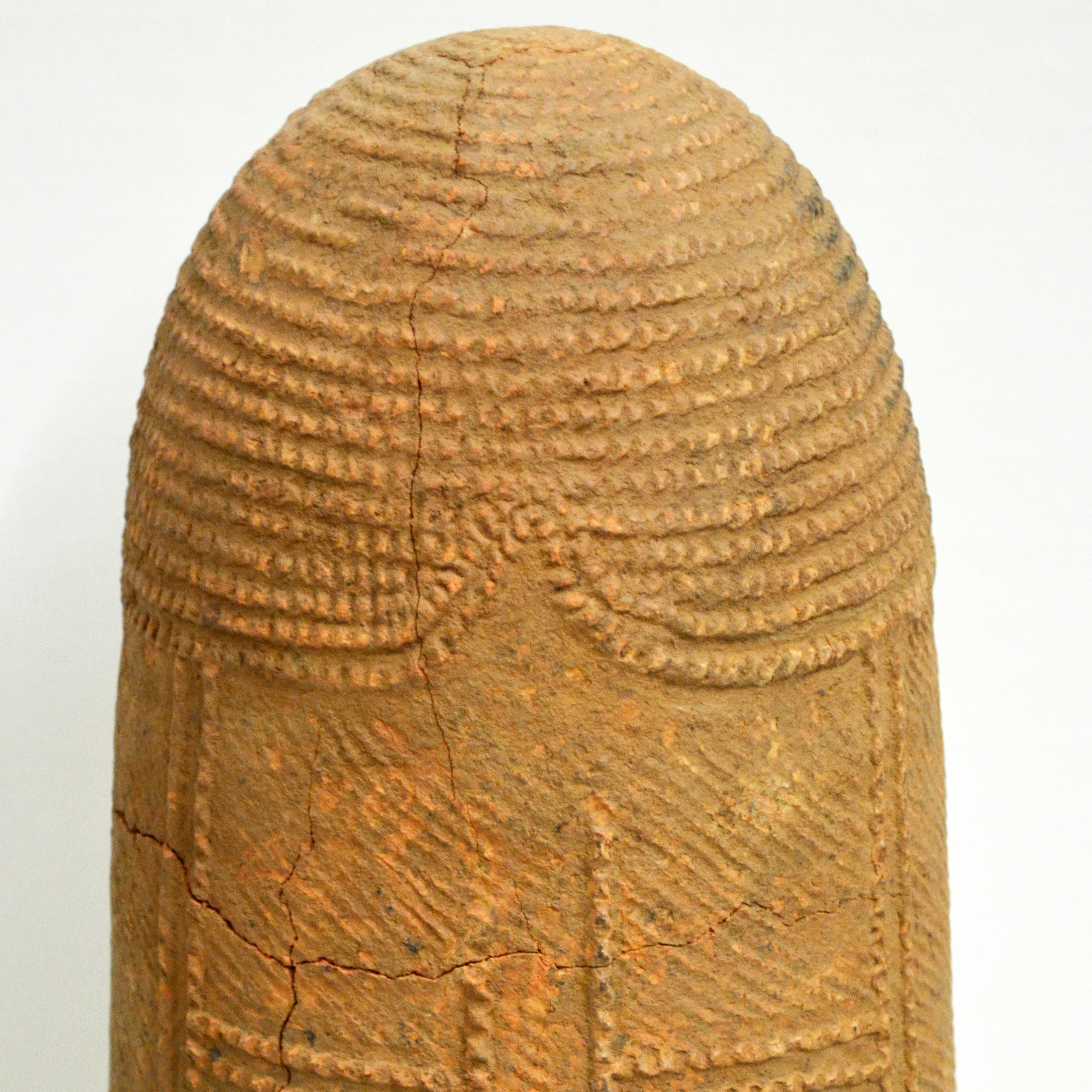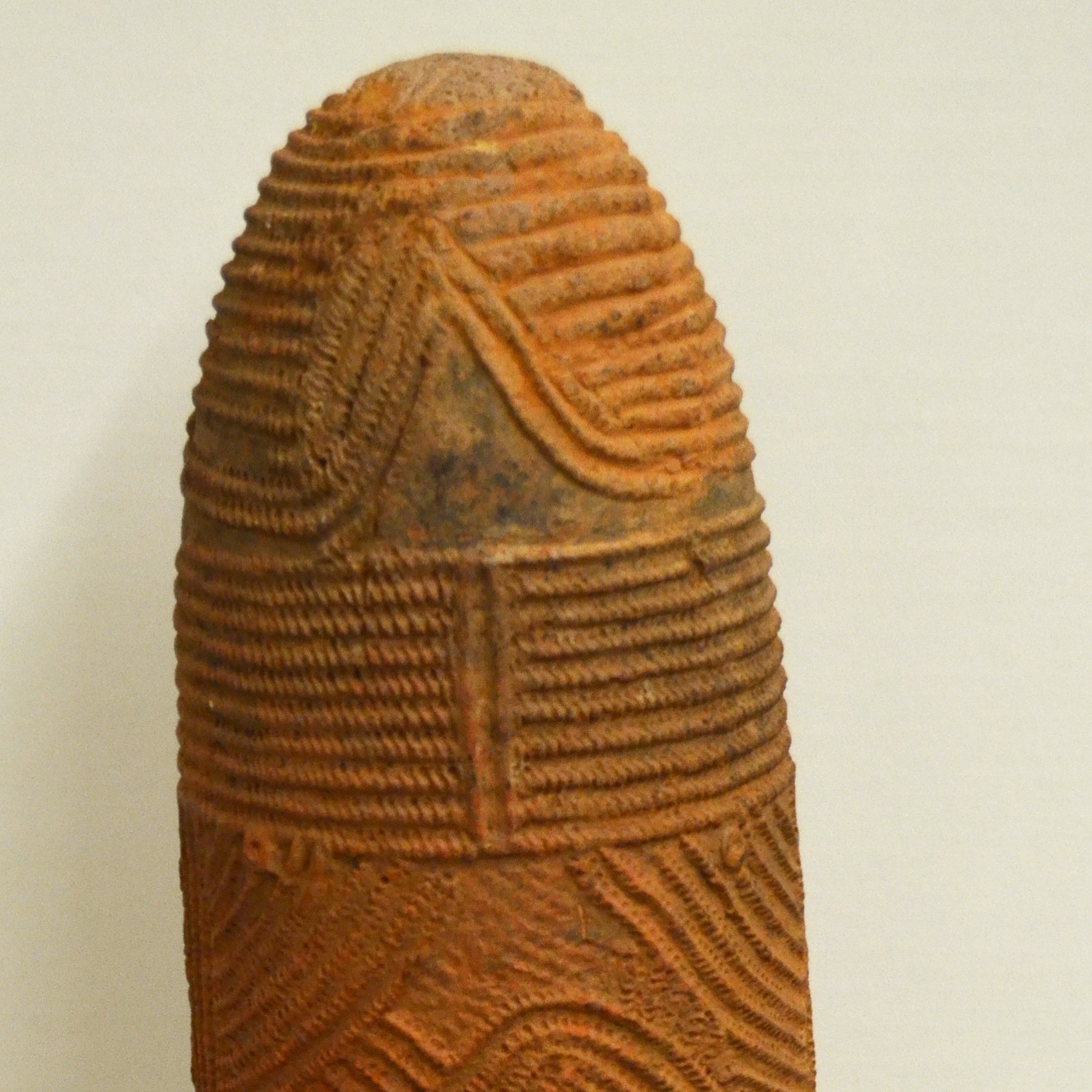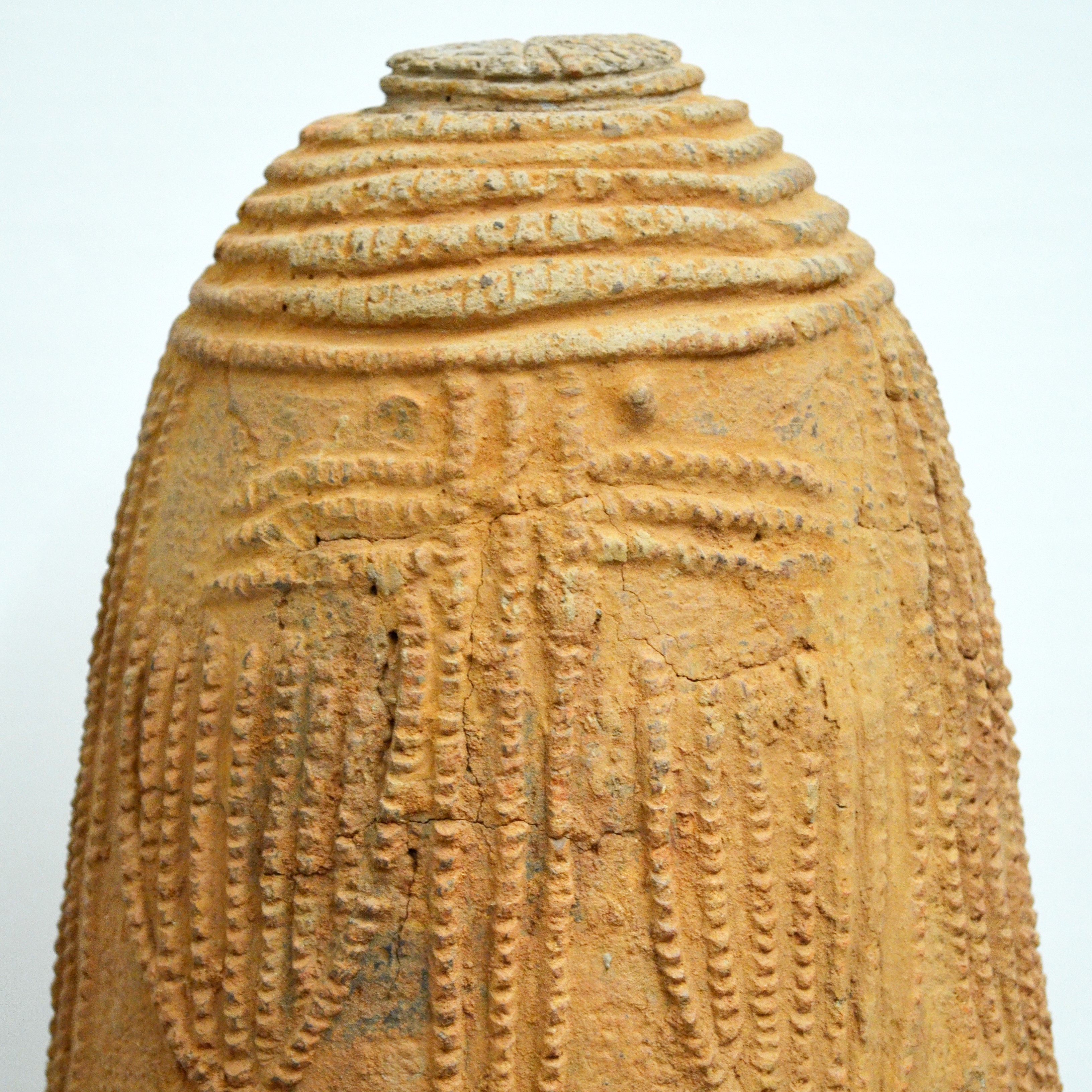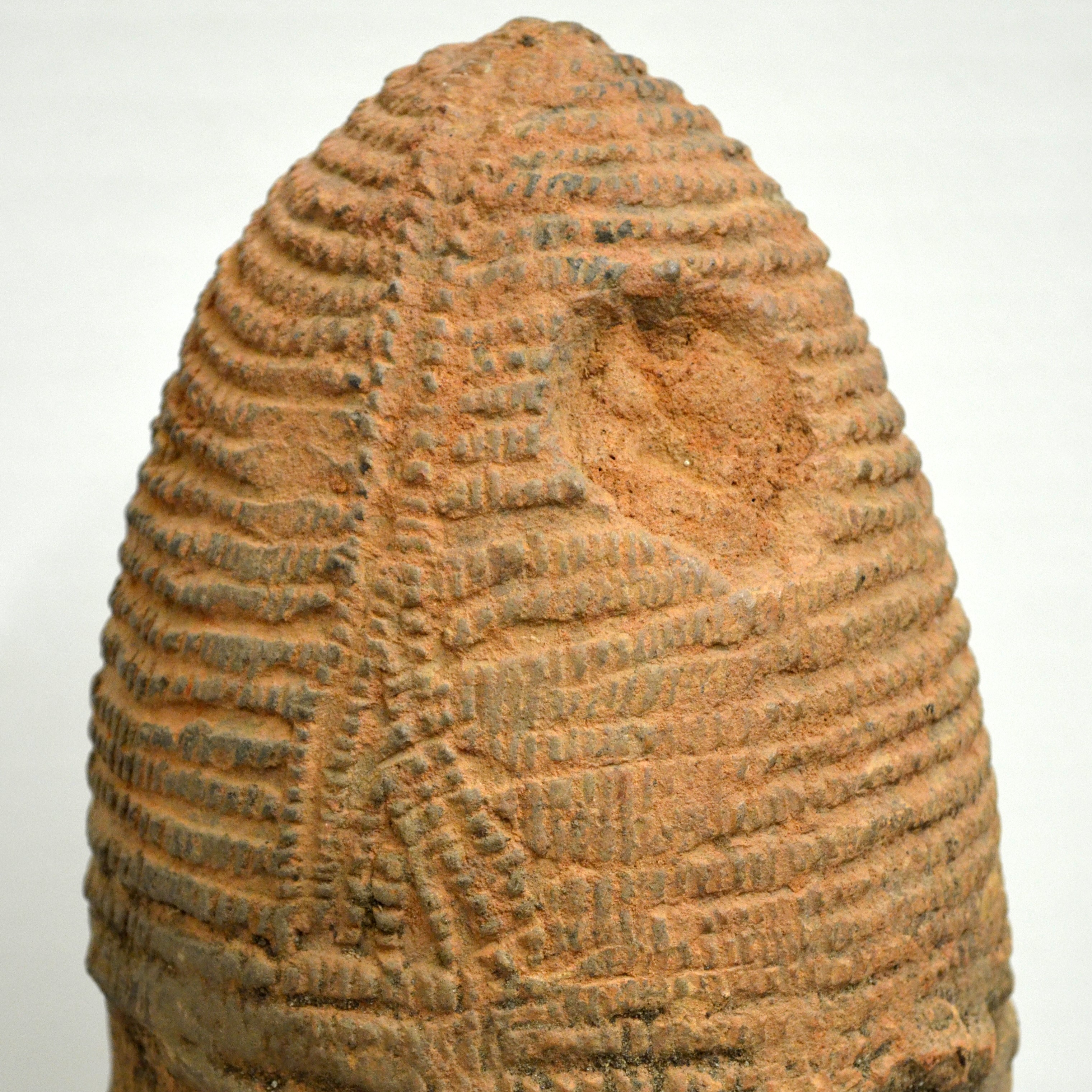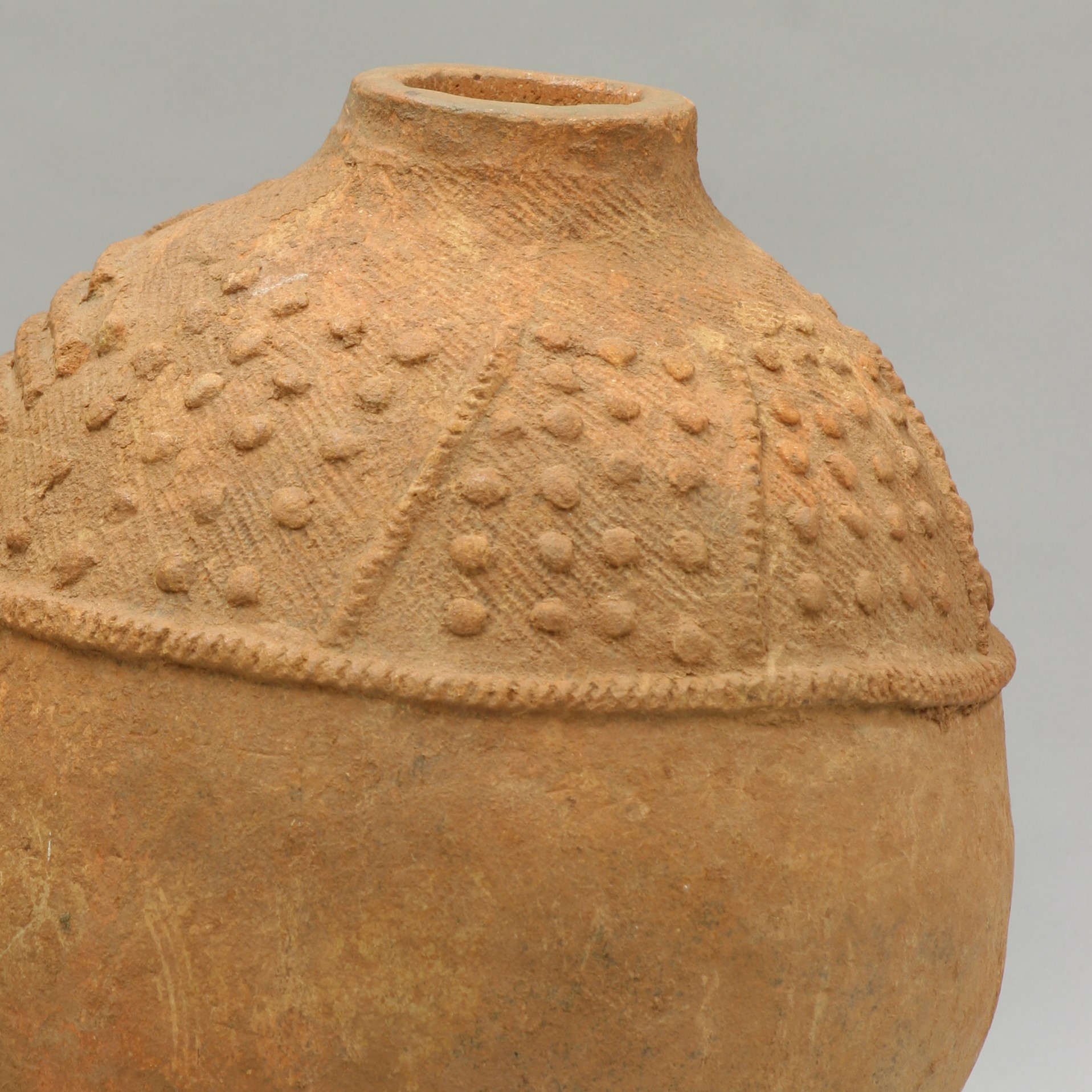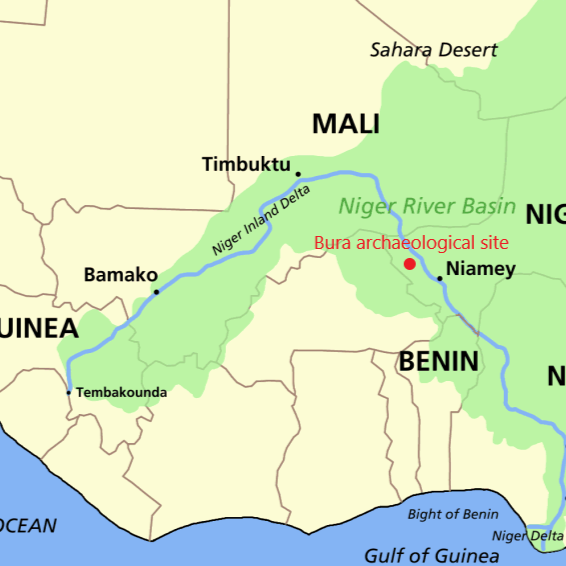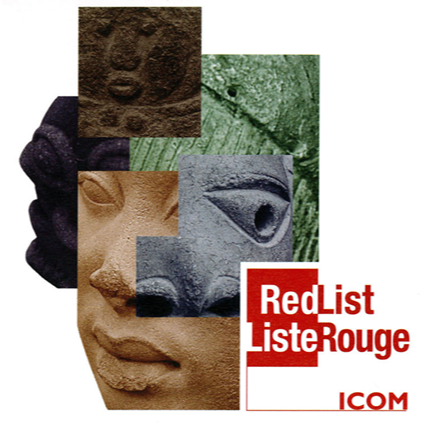African funerary vessels
Attributed to Bura civilization (Niger River Valley/Burkina Faso)
c. 500 BCE - 1000 BCE
terracotta
Permanent collection of the Mulvane Art Museum, Washburn University
Creation of these works has been attributed to the Bura civilization that settled throughout the Niger River Valley. Little is known about this culture apart from their death practices. Made from clay, the terracotta vessels were used as funerary urns for skeletal remains. Each cylindrical urn was placed upside down on the earth and could also contain personal items such as iron arrowheads, bracelets, or rings, and sometimes quartzite beads. Each urn is decorated with unique designs using a process called scarification, where marks are cut into the clay, as well as areas that are ridged. Designs are believed to represent aspects of the deceased’s life.
African funerary vessel
Attributed to Bura civilization (Niger River Valley/Burkina Faso)
c. 500 BCE - 1000 BCE
terracotta
Permanent collection of the Mulvane Art Museum, Washburn University
In contrast to the phallic-shaped vessels, this spherical terracotta funerary urn would be placed on the earth with the opening facing the sky. To protect the human skeletal remains and personal objects contained within, a secondary statuette—shaped and designed in either the likeness of the deceased or an animal effigy—would be placed in the opening. The funerary urn is decorated with designs that have been etched into the clay in a process called scarification, as well as areas of raised designs. Researchers believe these designs represent the lifeways of the deceased, perhaps their social status, the job they performed, or even the style of their hair.
Discover more
Archaeological sites along the Niger River Valley have been associated with the Bura civilization, and artifacts found there have been dated from the 2nd century to the 11th century based on stratigraphic data. The Institute for Research in Human Sciences (IRSH) has conducted archaeological research there since 1971, with the first small-scale dig occurring in 1978 after the accidental discovery of a statuette by villager Abdurahman Sindy in 1975. Eventually a full-scale dig began in 1983, and this site became known as a necropolis due to the 630 funerary urns and statuette busts that were uncovered.
Over the years, many more grave sites have been unearthed, and researchers have discovered three distinct cultural and geographic areas representing the nine-century span of the Bura civilization. They theorize that differentiation in the designs on funerary urns, busts, and statuettes can relate to age, sex, cultural aesthetic, and socio-professional groups. Additionally, some funerary urns contained only a skull, and researchers discovered human skeletal remains buried approximately 1 to 1.5 meters below these vessels. They attribute this differing burial practice to the social status of the buried individual, theorizing that the skull placed inside the urn belonged to a slave, servant, spouse, parent, or other person who was meant to function as a guardian in the afterlife.
Unfortunately, many of these Bura archaeological sites have been subjected to looting of artifacts, which has led to the sale of these historical objects to buyers all over the world.
All five of these ceramics were donated to the Mulvane Art Museum in 1995 by Jerry Vogel (1933-2014). Though there is little known about the provenance of these objects, information about the donor provides some context for understanding how they came to be in the Mulvane collection.
Jerry Vogel was born and raised in New York. He graduated from Hamilton College where he majored in English literature, and after receiving a Fulbright Scholarship, he spent a year studying in France. Upon graduating Vogel began his teaching career at Georgetown University, then made his way to Abidjan, Côte d’Ivoire (Ivory Coast) where he taught as a professor. In 1966, Vogel joined Operation Crossroads Africa, a cultural exchange organization that brought Africans to the United States to participate in training programs. During his career with Crossroads, he visited Cameroon, Central African Republic, Congo, Nigeria, Chad, Bafaoussam (West Cameroon), and Buea. In partnership with the Parsons School of Design, he also took student groups to visit Africa. Vogel held various positions at the Museum for African Art (now known as The Africa Center), founded by his wife, Susan Vogel.
As part of this research project, the possibility of having the five vessels carbon dated was explored. After consulting with staff at University of Georgia's radiocarbon dating lab, it was determined that the risk versus the reward of testing was too costly to continue. Due to the lack of soot, food residue, or organic material on the urns, the necessary sample size would have been destructive and results would not be reliable.
The International Council of Museums (ICOM) Red List identifies Bura terracotta objects as being at risk for illegal trafficking. Because of the geographical location and culture associated with the urns in the Mulvane collection, museum staff have raised questions about potential ethical issues surrounding the works' ownership. With little known about their provenance, there is a possibility that they could have come from questionable sources. Donor Jerry Vogel did not provide information about prior ownership to the Mulvane. However, he donated two additional Bura funerary urns to the Metropolitan Museum of Art, and he identified Alio Inka of Abidjan, Cote d’Ivoire, as their prior owner. It is possible Inka was an art dealer who also sold the Mulvane's urns to Vogel. More research is needed to establish provenance and determine whether the vessels in the Mulvane collection should be repatriated.
Bura phallic sculpture. Barakat Gallery Store. (2020, November 3). https://store.barakatgallery.com/product/bura-phallic-sculpture/
Chehab, D. (2014, November 29). Jerry Vogel, Africa veteran extraordinaire. Jerry Vogel, Africa Veteran Extraordinaire. https://nam10.safelinks.protection.outlook.com/?url=http%3A%2F%2Fwww.awayfromafrica.com%2F2010%2F07%2Fjerry-vogel-africa-veteran.html%3Fm%3D1&data=05%7C02%7Ccori.singleton%40washburn.edu%7C11dfb28fe3c64baa7cdb08dc2f38344c%7C8ef769ed956043a5966d2bc78c0bd006%7C0%7C0%7C638437165650443066%7CUnknown%7CTWFpbGZsb3d8eyJWIjoiMC4wLjAwMDAiLCJQIjoiV2luMzIiLCJBTiI6Ik1haWwiLCJXVCI6Mn0%3D%7C0%7C%7C%7C&sdata=hkprJC1tEZjY09ro%2FPTlVnQqoBCCyMbiQFc7qYGLSBI%3D&reserved=0
Devisse, J. (1993). Vallées du Niger: Paris, Musée National des Arts d’Afrique et d’Océanie. Ed. de la Réunion des musées nationaux.
Grave marker: Bura Peoples. The Metropolitan Museum of Art. (n.d.). https://www.metmuseum.org/art/collection/search/317898?sortBy=Relevance&ft=Bura%2Bpeoples&offset=0&rpp=40&pos=1
Insoll, T. (2003). In The Archaeology of Islam in Sub-Saharan Africa (pp. 325–331). essay, Cambridge University.
LaGamma, A., & Tucker, D. (2020). Sahel: Art and empires on the shores of the Sahara. Metropolitan Museum of Art.
Red List. ICOM. (n.d.). https://icom.museum/wp-content/uploads/2019/03/Emergency-Red-List-Egypt-French.pdf
